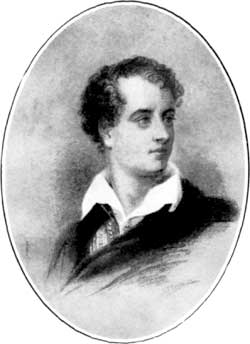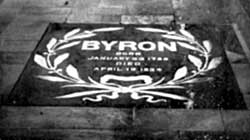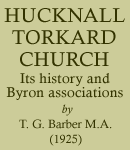"The brother of the 5th Lord, Admiral John, had an adventurous life. He recounted his own adventures, and in 1768 published the story of his hairbreadth escapes at sea. "Foulweather Jack" was the name by which he was known to his contemporaries. In 1748 he married the daughter of John Trevanyon, a Cornish Squire, and by her had two sons and three daughters. The eldest son, John; born in 1751, was the father of the Poet. He had a good education at Westminster, and eventually entered the army. His life was one of a profligate and a spendthrift, and his conduct soon alienated him from his family. He went through a legal form of marriage with the Marchioness of Carmarthen, after her husband had divorced her, and by her had two children. One died in infancy, the other was Augusta, the half-sister of the Poet. She married Colonel Leigh, and had a numerous family, most of whom died young. Tha tablet in the Chancel of the Church bears testimony to the affectionate esteem in which shs held her poet brother. It was her loving tribute to his memory:—
"His Sister,
The Honourable Augusta Mary Leigh,
placed this tablet to his memory."
John Byron's second wife was Miss Catharine Gordon of Gight, who had considerable estates in Aberdeenshire, and an honourable descent from James I. of Scotland. She was the mother of the Poet. All we know of his mother's character shows it to be proud, impulsive, and hysterical. Allowance must be made for all that she suffered at the hands of her profligate husband; at the same time no excuse can be found for the unsympathetic, and, at times, cruel treatment of her son. There can be no doubt that the poet's life was poisoned at its source, and that the training of his early years was responsible for that soured and extravagant nature which asserted itself so frequently in after life. Nevertheless, Byron held his mother in affectionate regard, and evinced deep sorrow at the news of her death. She was laid to rest in the family vault on August 9, 1811. The record of her burial is:—
The Entry of the Burial of the Poet's Mother, 1811 A.D.
1811.—August 9, The Honble. Catharine Gordon Byron, age 46.
The Poet did not follow his mother's body to the family vault. He stood at the hall door of Newstead, and watched the procession until it passed from sight; and then, so we are told, he asked the only servant remaining in the house to fetch the sparring-gloves, that he might engage in his usual exercise. At last, flinging the gloves from him, he retired to the quiet of his own room.
There is no evidence that he and his mother ever occupied the "Byron" pew in Hucknall Torkard Church, but it may reasonably be assumed that, when residing at Newstead, they would, from time to time, visit the family vault. On her coffin these words are inscribed:—
"The Honorable Catharine Gordon, of Gight, mother of George Lord Byron, and lineal descendant of the Earl of Huntly and the Lady Jean Stuart, daughter of King James the 1st of Scotland, obit in the 46th year of her age, August 1, 1811."

George Gordon Noel Byron.
In 1816 Byron left England and remained abroad until his death. Owing to financial embarrassments the sale of Newstead was forced upon him, and in 1818 the home of his ancestors passed from his possession. Six years later—April 19, 1824, he died at Missolonghi, in Western Greece. "engaged in the glorious attempt to restore that country to her ancient freedom and renown." In Greece there was a national lamentation. All offices and shops were shut, and there was a general mourning for 21 days. "England had lost her brightest genius—Greece her noblest friend," wrote Stanhope on hearing the news of his death. The cities of Greece contended for his body, but on May 2nd it left Zante for England on board the Florida. Upon the arrival of the brig at the London docks, the remains were removed to Great George Street, Westminster. In the Nottingham Review, July 16, 1824, it is stated that it was the wish of his half-sister that he should be buried in the family vault at Hucknall Torkard. Accordingly arrangements were made for the journey.
At 12 o clock on July 12 the funeral procession moved from Great George Street, Westminster. Six horses drew the hearse containing the coffin, on which was inscribed:—
George Gordon Noel Byron, Lord Byron of Rochdale,
Born in London, January 22, 1788,
Died at Missolonghi, in Western Greece,
April 19, 1824.
Behind the hearse was a mourning carriage, in which was placed the urn containing the heart and brains of the poet. A small ornamental pall was thrown over the urn.
The inscription on the urn is as follows:—
"Within this Urn are deposited the Heart, Brains, etc. of the deceased Lord Byron."

The Entry of the Burial of George Gordon Noel Byron, 1824 A.D.
The mourners who accompanied the body on its journey to Hucknall were:— Captain R. Byron, Colonel Leigh, J. B. Trevanyon, Esq., J. C. Hobhouse Esq., John Hanson, Esq . Sir Francis Burdett, Edward Ellice, Esq., Thomas Moore, Esq., Thomas Campbell, Esq., Samuel Rogers, Esq., Hon. Colonel Stanhope, and the servants of the household.
The funeral party, after halting at Welwyn, Higham Ferrers, and Oakham, arrived in Nottingham at 5 p.m. on Thursday, July 15. The coffin and urn were removed from the hearse and coach respectively, and carried into a room of the Blackmoor's Head Inn (Pelham Street), where they were viewed by thousands of people. At 11 o'clock on the morning of the next day the procession, augmented by two coaches, in which were the Mayor, two Aldermen, the Town Clerk, and Sheriffs, etc., representing the Corporation of Nottingham, moved along the Mansfield Road, and via Papplewick and Linby to the Wighay, and thence to the Church. It was at 3.40 p.m. that the hearse and coaches drew up at the entrance to the Churchyard.

The Byron Slab in the Chancel floor, the gift of the King of Greece.
The Church had been prepared for the funeral in the morning. The altar, rails, pulpit, and reading desk were draped with black, and beneath the pulpit cushion was hung an Escutcheon of the Byron Arms, with the motto, "Crede Byron." The Vicar, Rev. Charles Nixon, met the body at the Church gates, and led the procession through the main entrance into the Church. The coffin and urn were placed on trestles for the first part of the service, and at four minutes to four o'clock lowered by the attendants into the Vault. The bearer of the Cushion and Coronet stood in the Chancel at the entrance, whilst the Vicar read the remainder of the Service in the Sanctuary. When the service was over the mourners gathered round the vault, took their last look into its depths, and then turned away, leaving behind the body of one of the greatest geniuses the world has ever possessed to the custody of Hucknall Torkard Church, and its Vicar for the time being.
